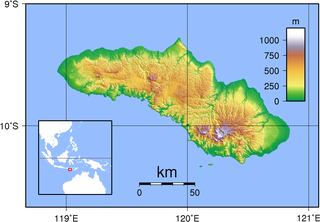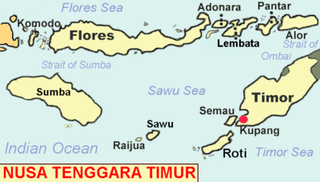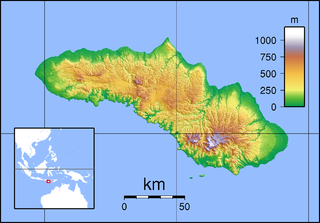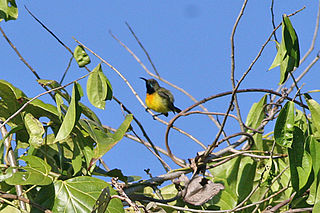
Sumba is an island in eastern Indonesia. It is one of the Lesser Sunda Islands and is in the province of East Nusa Tenggara. Sumba has an area of 11,006.62 square kilometres, and the population was estimated to be 805,716 in mid 2019. To the northwest of Sumba is Sumbawa, to the northeast, across the Sumba Strait, is Flores, to the east, across the Savu Sea, is Timor, and to the south, across part of the Indian Ocean, is Australia.

A megalith is a large pre-historic stone that has been used to construct a structure or monument, either alone or together with other stones. There are over 35,000 in Europe alone, located widely from Sweden to the Mediterranean sea.

The citron-crested cockatoo is a medium-sized cockatoo with an orange crest, dark grey beak, pale orange ear patches, and strong feet and claws. The underside of the larger wing and tail feathers have a pale yellow color. The eyelid color is a very light blue. Both sexes are similar. Females have a coppered colored eye where as the male has a very dark black eye.
The Marapu religion is a form of ancestral religion that is practiced mainly in the island of Sumba in Indonesia. Marapu is also practiced in many more remote areas of Sumba and Flores. Both the Christians and Muslims on these islands tend to combine their faiths with Marapu. Since Marapu, like Kaharingan of the Dayaks, is not an official religion of Indonesia, and all Indonesian citizens are required to identify as a member of one of the religions sanctioned by law, members have chosen either Christianity or Islam to self identify.

Savu is the largest of a group of three islands, situated midway between Sumba and Rote, west of Timor, in Indonesia's eastern province, East Nusa Tenggara. Ferries connect the islands to Waingapu on Sumba, Ende on Flores, and Kupang in West Timor. Flying to Savu through Susi Air from Kupang, Ende, and Waingapu is also possible.
Nesticella is a genus of spiders of the family Nesticidae. Most of its species are found in Asia—from Russia to Japan, down to Indonesia and several other islands, including New Guinea—though some species from Africa and South-America are also known. It includes a blind spider, Nesticella marapu.

The Sumba hornbill is a large bird in the Bucerotidae, or hornbill family. The scientific name commemorates British colonial administrator and zoological collector Alfred Hart Everett.

Manupeu Tanah Daru National Park is located on the island of Sumba in Indonesia. This national park consists lowland forests on steep slopes that rise up to ca. 600m.

Laiwangi Wanggameti National Park is located on the island of Sumba in Indonesia. All forests types that exist on this island can be found in this national park. Some endemic plant species are protected in this national park, such as Syzygium species, Alstonia scholaris, Ficus species, Canarium oleosum, Cinnamomum zeylanicum, Myristica littoralis, Toona sureni, Sterculia foetida, Schleichera oleosa, and Palaquium obovatum.
The little Sumba hawk-owl, also known as the little Sumba boobook or least boobook, is a species of owl in the family Strigidae. It is endemic to the Indonesian island of Sumba. Its natural habitat is subtropical or tropical moist lowland forests. It is threatened by habitat loss.

The apricot-breasted sunbird is a species of bird in the family Nectariniidae. It is endemic to the island of Sumba in Indonesia, where its natural habitats are subtropical or tropical moist lowland forests and subtropical or tropical moist montane forests. Although it is quite common, very little is known about its biology, with virtually nothing known about its breeding or diet.

The Sumba roundleaf bat is a species of bat in the family Hipposideridae. It lives in Indonesia and East Timor. It is present on the islands of Sumba, Rote, Sumbawa, Flores, Semau, and Savu.

West Sumba Regency is a regency in East Nusa Tenggara Province of Indonesia. Established in 1958, the regency was considerably reduced in 2007 with the creation of new Regencies on Sumba Island. Its area is now 737.42 km2, and its population was 111,993 at the 2010 census; the latest official estimate was 129,710. It has its seat (capital) in (Kota) Waikabubak.

Central Sumba Regency is a regency in East Nusa Tenggara of Indonesia. The new Central Sumba Regency was established when West Sumba Regency was split into two regencies in 2007 and a further Regency was created in Central Sumba from parts of both West Sumba and East Sumba Regencies. The new Regency covers 1,869.18 km2 and had a population of 62,485 at the 2010 Census; the latest official estimate is 73,820. The seat (capital) of its government is located at Waibakul.

The marigold lorikeet or Sumba lorikeet is a species of parrot that is endemic to the south-east Asian islands of Sumba, Rote, Wetar and Kisar (Indonesia) and Timor. It was previously considered a subspecies of the rainbow lorikeet, but following a review in 1997, it is increasingly treated as a separate species.
The Bima language, or Bimanese is an Austronesian language spoken on the eastern half of Sumbawa Island, Indonesia, which it shares with speakers of the Sumbawa language. Bima territory includes the Sanggar Peninsula, where the extinct Papuan language Tambora was once spoken. "Bima" is an exonym; the autochthonous name for the territory is "Mbojo" and the language is referred to as "Nggahi Mbojo." There are over half a million Bima speakers. Neither the Bima nor the Sumbawa people have alphabets of their own for they use the alphabets of the Bugis and the Malay language indifferently.
Kodi is a Sumba language of Indonesia. The population figure may include Gaura, which Ethnologue counts as a dialect of both the Lamboya and Kodi languages. Kodi is an Austronesian language that is mainly spoken in Nusa Tenggara Timur province, the western part of the island of Sumba in eastern Indonesia. An alternate name for Kodi is Kudi and dialects of the language include Kodi Bokol, Kodi Bangedo, Nggaro (Nggaura) and is most alike to Wejewa. With only approximately 20,000 speakers, the Kodi language is an endangered language.

The Sumba people are an ethnic group inhabiting Sumba Island, which is divided by two regencies, namely West Sumba Regency and East Sumba Regency. They refer to themselves as Tau Humba. The Sumbese have been able to retain much of their culture despite foreign influences that arrived long ago on the Lesser Sunda Islands.

The Lesser Sunda Islands are an archipelago in Maritime Southeast Asia, north of Australia. Together with the Greater Sunda Islands to the west they make up the Sunda Islands. The islands are part of a volcanic arc, the Sunda Arc, formed by subduction along the Sunda Trench in the Java Sea.

The Sumbanese traditional house refers to the traditional vernacular house of the Sumba people from the island of Sumba, Lesser Sunda Islands, Indonesia. Sumbanese house is characterized with its high-pitched central peak in its roof and strong connection with the spirits or marapu.













